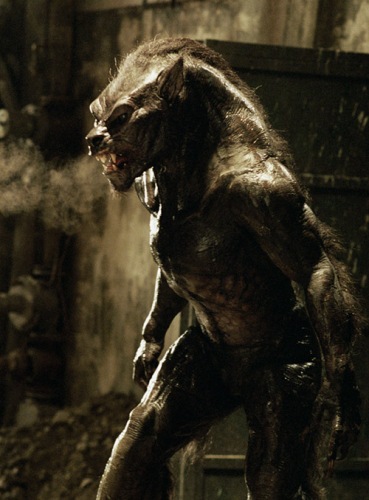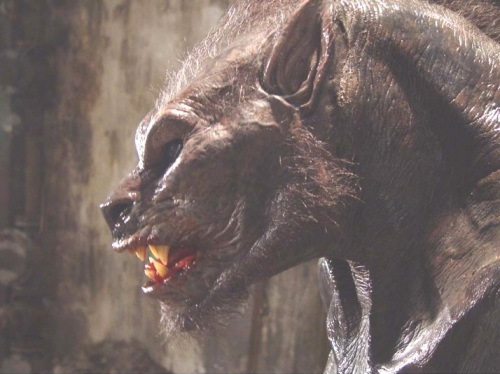“I have a background in genetic engineering,” said Kevin Grevioux, co-writer of Underworld — and the actor portraying Raze in the series. “Given that, I wanted to take a different approach to the worlds of Werewolves and Vampires in this film. I wanted to use science as a basis, rather than mysticism.” However powerful and durable in nature, the Werewolves of the Underworld films are not supernatural entities, but rather “oddities of nature” — as Alexander Corvinus states in the second film — grounded in the ‘unlikely’ reality of Science Fiction. Even before the design process for the monsters actually started, director Len Wiseman was adamant about how his Werewolves should be brought to the screen: practical effects — performers inside suits — were to be largely used.

“When we were going around pitching this idea for Underworld,” Wiseman recalled, “I did really want everybody to know that I wanted to go back to just doing practical creatures. I wanted a guy in a suit. We brought in footage, actually, of, you know, Alien or Aliens, or Pumpkinhead, or Predator. I just think there’s something that you get only in a guy in a suit, and I wanted to bring that back. I never really saw that as something wrong. Now a lot of movies have gone CGI and I actually thought we were getting better with the prosthetics.” The director later added: “I really wanted to combine the concept of using practical creatures — guys in suits — with the wire work that we have today, and just be able to get the movement, to make a Werewolf be able to bound in a hallway or jump to one wall to the next. You don’t actually need to use CGI to do that, and I think that’s a big push.”

Patrick Tatopoulos and his special effects Studios were hired by Wiseman to bring the creatures to life. Framestore CFC and Luma Pictures instead provided the digital effects. Wiseman and Tatopoulos had met many years before the project — on the set of Roland Emmerich’s StarGate. “I met in person Patrick when I was on StarGate,” Wiseman recalled, “working as a prop guy, and I fell in love with his design work and drawings in the art department.”

The fundamental intentions that drove Patrick Tatopoulos, much like in other cases, were to create a unique werewolf design unlike any other seen precedently in a film. He also incorporated feline traits into his design, to enhance the sense of agility. “We wanted to do something new and unique,” he said. “We didn’t want to do a type of wolf you see in every movie. The wolf suits had mechanical leg extensions and animatronic extensions for snarls and whatnot. I wanted to do something more catlike for the wolf. Obviously, werewolves are doglike, but I was going for something in-between. Adding catlike qualities to a wolf, for a more sleek look and a more agile animal.”
Given a werewolf is, by all intents and purposes, a hybrid of man and wolf, Tatopoulos and Wiseman decided to focus on this aspect of such concept. Unlike most movie Werewolves, the Underworld Lycans would not be heavily covered in fur. “I came to Patrick [and I said], ‘I really don’t want a lot of hair on these Wolves, because I actually want to see the structure,” Wiseman said. “I had seen a lot of stuff, faces of different creatures being built – and you look at the Werewolves, and you see the actual definition in the muscles. Then you put a bunch of hair all over and all that is lost, especially when you light it and it’s in the dark.”
Patrick Tatopoulos was also inspired by the iconic special effects work provided by Rick Baker for John Landis’ An American Werewolf in London. “I’ll tell you my inspiration,” the french Artist said to Latex Mask Central, “when I saw Rick Baker’s American Werewolf in London, I felt the best look to the werewolf was during the transformation stage. Not the beginning or end, but the wolf somewhere in the middle. There was the wolf [hybrid], somewhat scary and grotesque — and that’s what inspired me.” Tatopoulos would later pay homage to An American Werewolf in London with Lucian’s first onscreen transformation in Underworld: Rise of the Lycans. The actual fur covering of the Lycans is minimal: a mane runs from the forehead down to the end of the back, and crests of fur were placed to highlight the jawline, arms, and legs. It was also designed “to cover the rude bits.”

Once the Lycan design reached its final appearance, construction of the suits began. Steve Wang sculpted the head and body of the creatures, aided by Norman Cabrera and Don Lanning. The skin of the Werewolves was made in foam latex. The hair of the Lycans is appropriately painted Yak hair; each individual hair had to be manually ‘punched’ into the foam skin and then sealed with silicone.
Steve Wang suggested shaving the body core down in order for the suits to fit more tightly on to the actor. “Gabe Bartalos was in charge of casting and molding the actors and creating the core for the suits,” said Tatopoulos. “We body-casted one actor and we were able to extend that cast to fit the other actor, so we didn’t have to cast both actors for the chief wolf suits. Steve had a great idea that we shave down the body cast so that when we sculpt the suit on top of it, it will fit the actor very tight. Normally, you sculpt onto the lifecast and the suit fits loose, wrinkles and buckles in some places. Steve kept saying to sculpt smaller, sculpt smaller and as small as we did the suit, it still buckled around the waist, so Steve tailored the suit to fix these problems and I don’t know how he did it, but he did it very, very well.”

The main creature performers were Kurt Carley (who had precedently worked with Tatopoulos during the production of Roland Emmerich’s Godzilla) and Brian Steele; the actors first had to wear a tight body core, on which an ‘animatronic vest’ — containing receptors and cables that controlled the head mechanisms — was placed. The actors would then be covered in surgical jelly in order to slide comfortably into the suits. The most difficult aspect for them was, however, the massive heat inside the costumes. “Although both Kurt and Brian are gymnasts,” said SFX supervisor Guy Himber to Fangoria, “it’s not about athleticism so much as tolerating the heat and discomfort for hours on end and being able to smile about it. It’s Sweat City in there!” Tatopoulos Studios had precedently used leg extensions for Godzilla — on both the adult and baby creature suits. The technology was refined for Underworld, and gave the actors the ability to perform more agile and stable movements.
Although it was Len Wiseman’s intention to use practical effects as much as possible, Underworld still needed its share of visual effects to achieve some of the planned sequences. The digital creatures were created by CFC (selected based on their work on the Dinotopia miniseries) and Framestore. Many shots of the film were planned as practical but ultimately had to be aided by computer-generated imagery.
The most evident example of this is the ambush at the train station — when the Lycans attack and kill Amelia and her convoy. “There’s a shot where the Werewolves climb up to the top of the train, which we tried to do practically,” said James McQuaide, VFX supervisor of Underworld, “and soon, probably, the result of the practical attempt will be in the gag reel — because it looked absolutely horrendous. The creatures that flop up there looked very like The Creature from the Black Lagoon and just are comical. Len knew we could never use that — but it was a key shot to see these Werewolves on top of the train, so we went back to CFC in London and came up with the shot that is in the picture right now.” The shot was changed into the actual scene — the digital Lycans leaping up on the roof of the train.

The werewolf transformations were also achieved through computer-generated imagery — and were a particularly complex process for the visual effects artists. Artists at Framestore CFC had at their disposition digital scans of Kevin Grevioux’s head and of the werewolf heads — and from those they created a “morph that gave the sense, actually, of this werewolf face growing out of the human face.”

Rob Duncan, visual effects supervisor at Framestore, elaborated on the company’s website: “we worked on top of a live-action plate of the characters in their human form, developing them into their beast form. There were several occasions where we shot both the human and werewolf forms on camera, but most of the time we weren’t expecting to morph between one plate and another – most of the time we expected to start with the human and end with the CG version of the werewolf. When the transformation was complete, there’d be a cutaway or whatever and then we’d go back to an actor in a full body suit, on stilts, and with an animatronic head. But we did develop a full CG werewolf as various shots required stuff that the stuntmen couldn’t do.” A cut scene involved a Lycan transformation shown at 360 degrees during the process, which could not be achieved due to technological contraints of the time.
Len Wiseman gave directions to the visual effects artists and told them to make their work as much like an “old-school” practical effect as possible. “I wanted it to be shaky and look painful, I didn’t want it to be smooth,” the director said. “I actually told the [digital effects artists] to try and make the transformation look as much like an animatronic effect as possible. it actually looked like there were guys in there with bladders and everything.”
For more images of the Lycans, visit the Monster Gallery.
Next: Underworld: Evolution







[…] Lycanthropes of the Underworld (monsterlegacy.wordpress.com) […]
[…] amazed as I was upon learning that our strange and magnificent universe is capable of manifesting such oddities of nature. And, I can assure you that every word I have written above is either entirely true, or the result […]